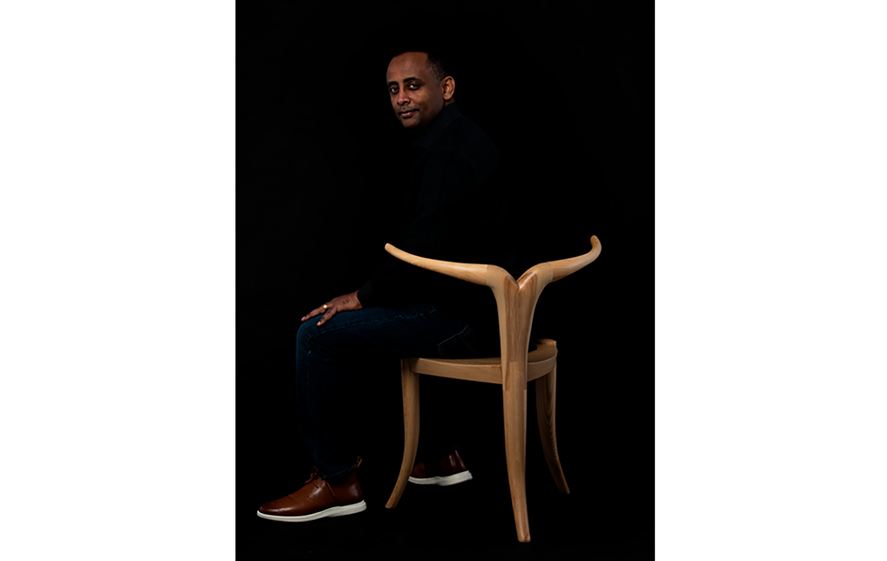Is Design a Universal Language?
More Advocacy, Investment Needed to Elevate Black Voices in Design
Ethiopian-American furniture designer Jomo Tariku’s story reads like a Hollywood tale – literally. You’ve likely seen his work in “Black Panther: Wakanda Forever.” His bold and intriguing African-inspired designs are featured in the film and are set to appear in other productions. Two of Jomo’s works furnish US Vice President Kamala Harris’ residence (the Naval Observatory), are displayed at the Metropolitan Museum in New York and he’s appeared in dozens of publications. Despite it all, Tariku says he feels “huge disappointment” toward an industry that’s widely embraced him.
“I started realizing, even in college, the lack of representation [of Black designers]. As my career evolved, I was almost always the only or one of the few Black individuals at major design events,” says Tariku. “I didn’t see or interact with anyone like me. I began to wonder how many Black designers there were.”
Tariku began doing research to answer his own question. Surveying more than 150 of the world’s most prominent design and furniture brands, he learned Black designers made up less than one percent of all the designers affiliated with these firms. Tariku’s findings are reinforced by hard data from the Bureau of Labor Statistics: art and design are among the least diverse professions across a field of hundreds. Steelcase recognizes the role our industry plays in changing these realities. In honor of Black History Month, the Diversity, Equity and Inclusion team at Steelcase organized a learning and development session, called Curious Minds, to learn more about the issue, discuss it with Tariku, and accelerate our own strategies on talent in design.
“We’ve all heard the phrase, design is a universal language. But if that universal language doesn’t represent our culture, design thinking and design theory – if that is missing – you can’t keep arguing the point that design is a universal language,” Tariku says.

He believes the root of the issue lies in Eurocentric design dominance in global furniture design. African and African American perspectives are rarely amplified in the western canon – and when they are, they often feature stereotypical animal prints or icons while lacking the diverse depth of true African design concepts.
“We’ve been missing in the canon” argues Tariku. “When I say canon – it’s where our influence is preserved as long as humans exist. The libraries, museums, galleries – this is where our work will be recognized forever.”
Because the work of Black designers isn’t prominent, people don’t find the representation that signals their unique perspective is valued.
“If you don’t think or see that there are things your culture has contributed you’re not going to base your entire career on it. If they don’t see it, they won’t aspire to it and carry the culture forward.”
Jomo TarikuEthiopian-American designer
Born in Kenya and raised in Ethiopia, his cultural background brings a fresh perspective and expands the creative landscape overall. In essence, the importance of embracing diversity in design not only fosters inclusivity, but enriches the creative dialogue that ensures a wider representation of ideas.
Tariku acknowledges the dearth of Black designers is a long-range problem with no simple solution. One place to start is through advocacy on behalf of the Black design community. Recently, various Black creative collectives like the Black Artist Designers Guild (BADG) have increased pressure on design industry magazines to change their type of coverage, retailers to collaborate with Black creatives, and museums to broaden their curation of cultural art and design. These groups are also creating new media content and raising social awareness of the issue. BADG also awards grant money for projects connected to amplifying and archiving the Black experience – fostering investment that sustains Black artists and designers.
Looking forward, Tariku believes organizations must do more to intentionally engage and support Black designers.
“It takes funding and intentional investment,” Tariku says. “People like me donate our stools and chairs for fundraisers for scholarships and things – but again, it’s back on us. We need Corporate America to be serious about licensing, hiring and engaging with Black artists and designers consistently.”
Jomo Tariku is the co-founder of Black Artist Designers Guild (BADG), weASPiRE and has recently founded ARTiculate Design Lab. Over the years he has mentored many up-and-coming designers from Africa as well as the U.S. He lives in Springfield, Virginia with his wife and two sons.

